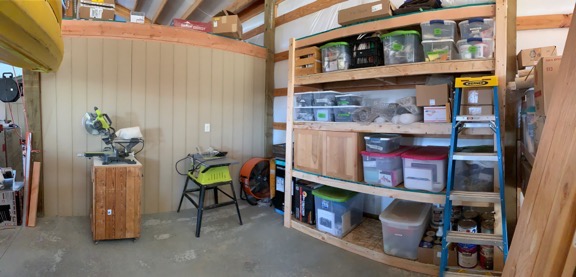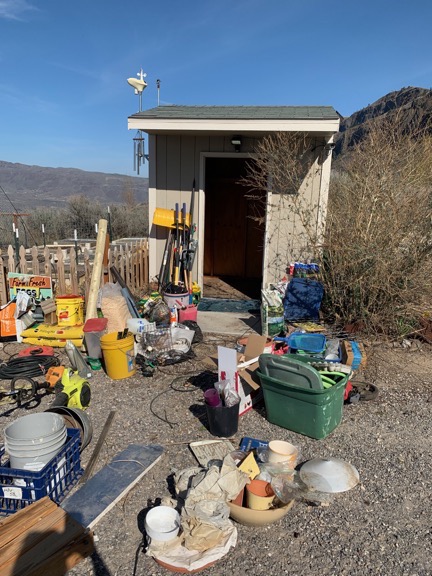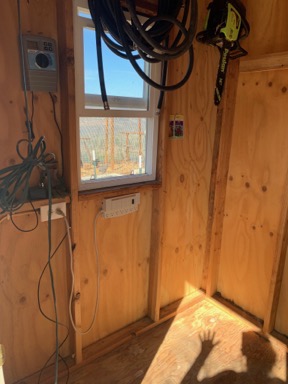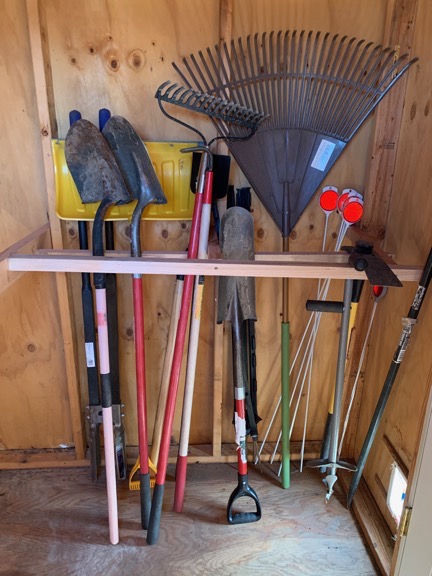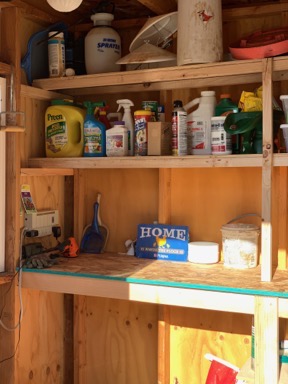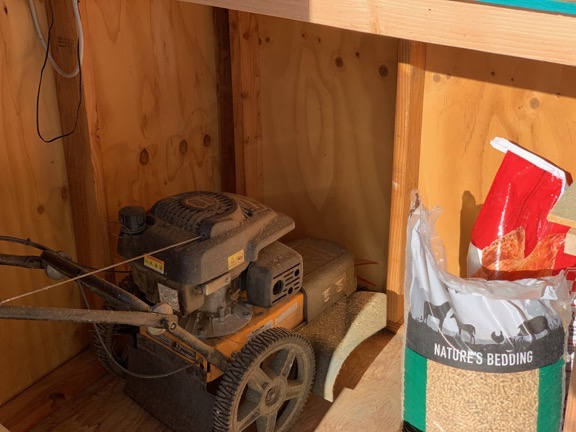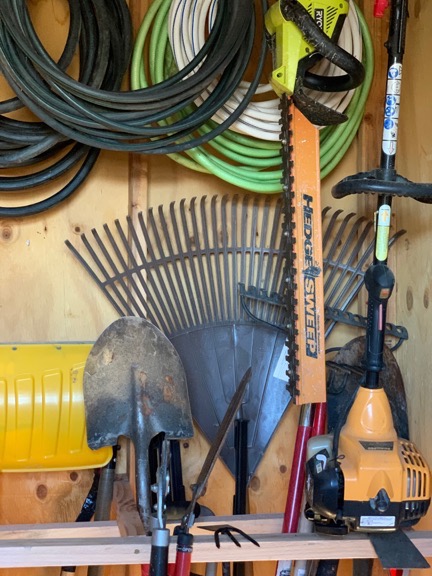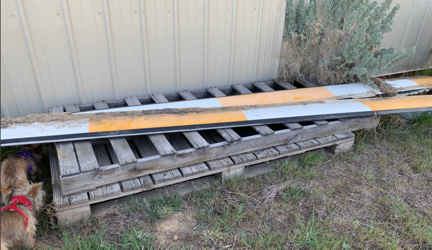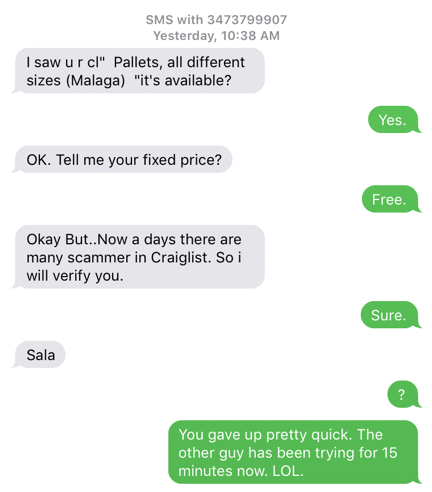I add a custom permanent storage solution to my garden shed.
Folks who have reading this blog for a while or know me know that I have a very big garage. But it wasn’t the first of the three (so far) buildings on my property. The first was a wooden storage shed.
A Short History of the Shed at My Property
I got the shed back in 2013, not long after I’d bought the 10 acres I subsequently built my home on. I was living in my old fifth wheel back then, the “Mobile Mansion,” which was fully hooked up to 30 amp power, city water, and a brand new septic system. I had everything I needed until I was ready to built — everything except nearby storage. My extra vehicles and household possessions were stored in a hangar at the airport with my helicopter. It was a 30-40 minute drive (depending on how I drove) and not at all convenient for larger items I might need around the property. The Mobile Mansion had a decent sized “basement,” but it just wasn’t big enough, considering I had to clear it out to install heaters down there for the winter.
As the blog post I linked to above details, I got a smoking deal on the shed and it was perfect for my needs. They installed it on the south side of my driveway, not far from my electrical box. I wasted no time assembling IKEA shelves I had from my old house inside it to make the best of its 6 x 8 foot space. I moved a bunch of yard stuff in there for the winter.
Fast forward to the following spring when I started prepping to build my home. My favorite dirt guy, Jeff, used various heavy equipment to prepare a building site by leveling and compacting soil. While he was there with all that equipment, I asked him to clear a space for my garden and future chicken yard and relocate my shed to the other side of the driveway. This turned out to be a lot easier than I expected. The shed was heavy-duty and built on skids. Once he was able to attach chains around it, he was able to drag it across the driveway and nudge it into position. We even got it relatively level.
The shed became the “safe place” for a series of barn cats I got from the local Humane Society. They had a program to rescue feral cats. They’d catch them and neuter them and then send them home with people who had mouse problems. Although I didn’t have a mouse problem, I had a snake problem. Snakes eat mice. I figured I’d get rid of the mice — or at least reduce the mouse population — and I should reduce the number of snakes. The program required a safe place the cats could easily access to escape predators. So I put a cat door in the shed, set it up for cat occupation, and did what I had to care for feral cats. The experiment, which involved five cats over two years, was a failure, mostly because the cats didn’t like being chased by my dog, Penny, and eventually moved out. One of them — Black Bart — lives at the local winery and I heard rumors that another was also still in the neighborhood. I don’t know about the rest.
(I subsequently solved the problem by adopting two kittens and raising them with Penny. They became friends and didn’t run off. By that time, I wanted them in my garage so I put a second cat door there. One of them occasionally uses the cat door into the shed.)
Over time, the shed did what sheds do: it collected all kinds of yard junk: flower pots, chicken feed bags, chicken coop bedding, rakes, shovels, insecticides, weed killer, fertilizers, irrigation supplies — you get the idea. If it was remotely related to gardening or chicken maintenance, it went into the shed. The shelves became crowded. Mice moved in. Soon it became difficult to open the door, let alone find anything that might be in there.
It was time for me to do something about it.
The Big Shelf Build
Last week, I was in a shelving state of mind. For over a year, I’d been wanting to clear out a 12×12 section of my garage, build shelves against one wall, remove some flimsy IKEA shelves, and move my table saw and chop saw in. I ordered the lumber and picked it up. One afternoon, I started building an 8x8x2 shelf unit. I built it in place so I wouldn’t need help lifting or moving it. It was great to get it done.

Here’s a pano — hence the distortion — image of the new wood cutting area in my garage. The shelves are brand new but match another set I built years ago in the back 12×12 corner of the garage: sturdy and functional, but not necessarily attractive.
I purposely bought too much lumber. (In my world, you can never have enough 2x4s.) I had also bought a bunch of 2x2s for another garage project. And I had all kinds of scrap lumber from other projects. So I had everything I needed to build shelves in the shed, including that state of mind.

Hard to believe that all of this was inside the shed. Believe it or not, only 10% of it was stuff I could throw out; I needed everything else.
The first step, of course, was to clear everything out of the shed. I went over to take a look on Thursday afternoon and, before I could stop myself, I’d begun pulling stuff out. Within an hour, I had everything outside on the driveway. I’d also evicted at least six mice and used my big ShopVac to suck pounds of dirt, mouse droppings, and cat crap — remember the barn cats? — out. Clean slate.


It’s difficult to take a photo of such a small space, but here’s the left and right side of the shed from the doorway.

My slightly oversized “tool corral” is where I can keep long handled yard tools organized and out of the way.
I’d already decided to move the garden tools — shovels, rakes, hoes, etc. — off the beat up rack on the back wall (which was the first to be thrown away) and into a “corral” on the right side, behind the door which, for reasons I’ll never understand, opens in.
I then went to work on the shelves that would cover the back wall. I needed a design that gave me lots of shelf space, but also a bit of working area, like a workbench. I needed space underneath to store bags of chicken feed and coop bedding. I also needed space to park my small brush mower, which was taking up too much space in my garage. I came up with a design that had a lower shelf on half the wall, a relatively high, wide counter-like shelf, and two shelves above that. The lower two shelves were about 2 feet deep while the upper two shelves were only a foot deep. I used my jig saw to cut out the shapes of the shed studs so the deep shelves went all the way back to the wall, limiting the possibility of things falling down to the floor.
The work went slowly with lots of walking back and forth between the shed and my garage where my saws were. On Friday, my FitBit knockoff recorded over 8,000 steps.
I got the lower shelves done on Thursday. I’d made them by measuring up from the floor but, for some reason, the shelves weren’t level. I told myself a half dozen times that this was just a shed and it didn’t matter and eventually I believed it. But I figured I’d get the upper shelves right by measuring up from the top shelf in one spot and using a level to set the shelves in place. I soon realized that they looked really off. What the hell was going on? The answer was simple; one side of the shed had settled after it was moved and it was no longer level. So the shelves, when they were empty, looked like something out of a Dali sketch.
When the shelves were done and my power strip was relocated away from its space beneath the window — what was I thinking with that original placement? — I started putting stuff away. Neatly. I brought plastic shoeboxes I had in the garage out, labeled them, and sorted various things into them.


Here are the upper shelves, neatly organized.

My mower fit easily into the corner on the left. Easy in, easy out.

The lower shelves and storage space on the right holds my bin full of irrigation parts and other large items.
I updated the tool corral area, too, by adding hooks over it for rolled up hoses and a few power tools that could be hung there.
As you might imagine, I was very pleased with the way it turned out. Best of all, I’d gotten all that junk back off my driveway.
Now I just need to figure out what to do with those old IKEA shelves.


